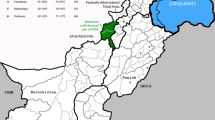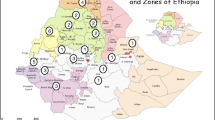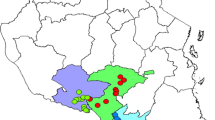Abstract
Genetic diversity of 35 Psidium guajava L. accessions and three related species (P. guineense Sw., P. sartorianum (O. Berg) Nied. and P. friedrichsthalianum (O. Berg) Nied.) maintained at the U.S. Department of Agriculture (USDA), National Plants Germplasm System, Hilo, HI, was characterized using 20 simple sequence repeat (SSR) markers. Diversity analysis detected a total of 178 alleles ranging from 4 to 16 alleles per locus. The observed mean heterozygosity (0.2) and inbreeding coefficient (0.8) indicated a high level of inbreeding among the accessions tested. Multi-locus DNA fingerprints based on the 20 SSR loci unambiguously differentiated all accessions and revealed the absence of duplicated samples. Ordination and cluster analyses suggested that the genetic relationships between majorities of the accessions could be explained by geographic origin, mainly including tropical America, Southeast Asia and Hawaii. A Bayesian cluster analysis partitioned the accessions into two groups and the partition was largely compatible with the result of ordination analyses. Distance-based cluster analyses further indicated that accessions from same geographical region or breeding programs grouped together in spite of the inter-regional exchange of germplasm. Accessions from Southeast Asia were dominantly white fleshed, whereas accessions from tropical America and Hawaii exhibited diverse flesh colors. The results also indicated that accessions from the same region were likely derived from a small number of common ancestors or progenitors. All 20 SSRs were transferable to P. guineense, P. sartorianum and P. friedrichsthalianum, indicating a close relationship between the cultigens and wild relatives. Application of SSR markers in the USDA/Agricultural Research Service germplasm collection provides new insight into the diversity of the guava germplasm, which will be valuable in future breeding endeavors and the conservation of guava genetic resources.




Similar content being viewed by others
References
Bucheli E, Gautschi B, Shykoff A (2001) Differences in population structure of the anther smut fungus Microbotryum violaceum on two closely related host species, Silene latifolia and S. dioica. Mol Ecol 10:285–294
Crane JH, Balerdi CF (2012) Growing guava in the Florida landscape. University of Florida, Institute of Food and Agricultural Sciences, Extension Bulletin # HS 4:1–8. http://edis.ifas.ufl.edu/mg045
Dieringer D, Schlötterer C (2002) Microsatellite analyser (MSA): a platform independent analysis tool for large microsatellite data sets. Mol Ecol Notes 3:167–169
Earl Dent A, vonHoldt Bridgett M (2012) STRUCTURE HARVESTER: a website and program for visualizing STRUCTURE output and implementing the Evanno method. Conserv Genet Resour 4(2):359–361
Evanno G, Regnaut S, Goudet J (2005) Detecting the number of clusters of individuals using the software STRUCTURE: a simulation study. Mol Ecol 14:2611–2620
Felsenstein J (1989) PHYLIP-Phylogeny Inference Package (version 3.2). Cladistics 5:164–166
Feria-Romero IA, Astudillo-Dela HV, Chavez-Soto MA, Rivera-Arce E, Lopez M, Serrano H, Lozoya X (2009) RAPD markers associated with quercetin accumulation in Psidium guajava. Biol Plant 53:125–128
Kanupriya C, Madhavi Latha P, Aswath C, Reddy L, Padmakar B, Vasugi C, Dinesh MR (2011) Cultivar identification and genetic fingerprinting of guava (Psidium guajava) using microsatellite markers. Int J Fruit Sci 1:184–196
Morton JF (1987) Myrtaceae; Guava. In: Dowing CF Jr (ed) Fruits of warm climates. Julia F Morton Publishers, Miami, pp 356–363
Nakasone YH, Paull RE (1998) Tropical fruits. Crop production science in horticulture series. CAB International, Wallingford, pp 149–172
Page RDM (1996) Treeview: an application to display phylogenetic trees on personal computers. Cabios 12:357–358
Pathak RK, Ojha CM (1993) Genetic resources of guava. Advances in horticulture. Malhotra Publishing House, New Delhi, pp 143–147
Peakall R, Smouse PE (2006) GenAlex 6: genetic analysis in Excel. Population genetic software for teaching and research. Mol Ecol Notes 6:288–295
Peakall R, Smouse PE (2012) GenAlEx 6.5: genetic analysis in Excel. Population genetic software for teaching and research-an update. Bioinformatics 28:2537–2539
Peakall R, Smouse PE, Huff DR (1995) Evolutionary implications of allozyme and RAPD variation in diploid populations of dioecious buffalograss Buchloe dactyloides. Mol Ecol 4:135–147
Preece WE (ed.) (1981) Fruit nutrient composition table. Encyclopedia Britannica 7:766
Pritchard JK, Stephens M, Donnelly P (2000) Inference of population structure using multilocus genotype data. Genetics 155:945–959
Risterucci AM, Duval MF, Rohde W, Billottte N (2005) Isolation and characterization of microsatellite loci from Psidium guajava L. Mol Ecol Notes 5:745–748
Rodriguez N, Valdes-Infante J, Becker D, Velazquez B, Gonzalez G, Sourd D (2007) Characterization of guava accessions by SSR markers, extension of the molecular linkage map, and mapping of QTLs for vegetative and reproductive characters. Acta Hortic 735:201–215
Saitou N, Nei M (1987) The neighbor-joining method: a new method for reconstructing phylogenetic trees. Mol Biol Evol 4:406–425
SAS (1999) SAS Version 8.02: SAS/STAT Software: changes and enhancements through Release 8.02. SAS Institute Inc, Cary, NC
Setiawan B, Sulaeman A, Giraud DW, Driskell JA (2001) Carotenoid content of selected Indonesian fruits. J Food Compos Anal 14:169–176
Singh R, Sehgal OP (1968) Studies on blossom biology of Psidium guajava L. (guava). II. Pollen studies, stigma receptivity, pollen and fruit set. Indian J Hortic 25:52–59
Singh RB, Rostogi SS, Singh R, Gosh S, Niaz MA (1992) Effects of guava intake on serum total and high-density lipoprotein cholesterol levels and on systemic Blood pressure. Am J Cardiol 70:1287–1291
Tautz D (1989) Hypervariability of simple sequences as a general source for polymorphic DNA markers. Nucleic Acids Res 17:6463–6471
Valdés-Infante J, Rodriguez NN, Becker D, Velazquez B, Sourd D, Espinosa D, Rohde W (2007) Microsatellite characterization of guava (Psidium guajava L.) germplasm collection in Cuba. Cultiv Trop 28:61–67
Wright S (1965) The interpretation of population structure by F-statistics with special regard to systems of mating. Evolution 19:395–420
Acknowledgments
Financial support of the USDA-CSREES through an award Agreement 2004-38814-15128 to The Fort Valley State University is greatly appreciated.
Author information
Authors and Affiliations
Corresponding author
Rights and permissions
About this article
Cite this article
Sitther, V., Zhang, D., Harris, D.L. et al. Genetic characterization of guava (Psidium guajava L.) germplasm in the United States using microsatellite markers. Genet Resour Crop Evol 61, 829–839 (2014). https://doi.org/10.1007/s10722-014-0078-5
Received:
Accepted:
Published:
Issue Date:
DOI: https://doi.org/10.1007/s10722-014-0078-5




